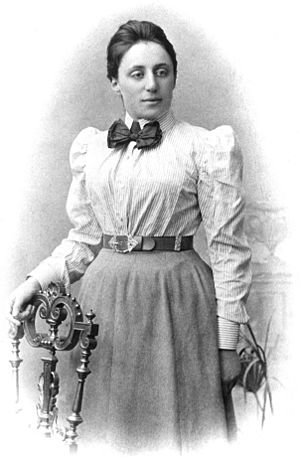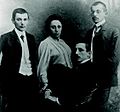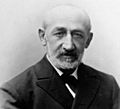Emmy Noether facts for kids
Quick facts for kids
Emmy Noether
|
|
|---|---|
 |
|
| Born |
Amalie Emmy Noether
23 March 1882 Erlangen, Bavaria, German Empire
|
| Died | 14 April 1935 (aged 53) |
| Nationality | German |
| Alma mater | University of Erlangen |
| Known for |
|
| Awards | Ackermann–Teubner Memorial Award (1932) |
| Scientific career | |
| Fields | Mathematics and physics |
| Institutions | |
| Thesis | On Complete Systems of Invariants for Ternary Biquadratic Forms (1907) |
| Doctoral advisor | Paul Gordan |
| Doctoral students |
|
Amalie Emmy Noether (born March 23, 1882 – died April 14, 1935) was a German mathematician. She made huge contributions to a field of math called abstract algebra. This is a type of math that looks at general rules and structures, not just numbers. Many famous scientists like Albert Einstein called her the most important woman in the history of mathematics.
Emmy Noether also discovered two important ideas known as Noether's First and Second Theorems. These are super important in mathematical physics. They help explain the connection between symmetry (when something looks the same even if you move it) and conservation laws (rules that say certain things, like energy, always stay the same).
Contents
Emmy's Early Life and Education
Emmy Noether was born in 1882 in Erlangen, Germany. Her father, Max Noether, was also a mathematician. She was the oldest of four children. As a child, Emmy was clever and friendly, but she didn't seem like a math genius right away. She was a bit nearsighted and had a small lisp. Like most girls then, she learned to cook and clean. She also took piano lessons, but she loved to dance more than anything.
Her brother, Fritz Noether, also became a famous mathematician. Sadly, he was executed in the Soviet Union in 1941.
Becoming a Math Student
Emmy first planned to teach French and English. In 1900, she passed the exams to teach these languages. But she decided to study mathematics instead, which was a very unusual choice for a woman at that time.
The University of Erlangen, where her father taught, didn't really want women students. In fact, they had said that allowing boys and girls to study together would "overthrow all academic order." Emmy was one of only two women among nearly 1,000 students. She was only allowed to listen to classes, not fully participate. She even needed special permission from each professor.
Despite these challenges, she kept going. In 1903, she passed her graduation exam in Nuremberg. Then, she spent a winter semester at the University of Göttingen. This was a very famous math research center. Soon after, the rules against women studying there changed.
Emmy returned to Erlangen in 1904. She decided to focus only on mathematics. She wrote her main paper, called a dissertation, under the guidance of Paul Gordan. She finished it in 1907.
Teaching and Research Challenges
After getting her doctorate, Emmy worked at the Mathematical Institute of Erlangen for seven years. She didn't get paid for this work. At that time, it was very hard for women to get paid jobs in universities. Sometimes, she even filled in for her father when he was too sick to teach.
Moving to Göttingen
In 1915, two famous mathematicians, David Hilbert and Felix Klein, invited Emmy to join the math department at the University of Göttingen. They knew how brilliant she was. But some professors, especially those in history and language, didn't want a woman to teach. One professor even asked, "What will our soldiers think when they return to the university and find that they are required to learn at the feet of a woman?"
Hilbert famously replied, "I do not see that the sex of the candidate is an argument against her admission... After all, we are a university, not a bathhouse!"
Emmy moved to Göttingen in April 1915. Her mother died suddenly around the same time. Her father retired, and her brother joined the German Army during World War I. Emmy went back to Erlangen for a few weeks to care for her father.
For her first few years at Göttingen, she still didn't have an official, paid job. Her family paid for her living costs. Her lectures were often listed under Hilbert's name, and she was just called his "assistant."
Noether's Theorem in Physics
Soon after arriving at Göttingen, Emmy proved a very important idea. It's now known as Noether's theorem. This theorem shows that for every continuous symmetry in a physical system, there is a conservation law.
For example, if the laws of physics are the same no matter where you are in space, then linear momentum is conserved. If they are the same no matter when you do an experiment, then energy is conserved. If they are the same no matter how you turn something, then angular momentum is conserved.
This theorem is a basic tool in modern physics. It helps scientists understand conservation laws and even guess what new physical laws might be like.
Finally, a Professor!
After World War I ended, Germany changed a lot. Women gained more rights. In 1919, the University of Göttingen finally allowed Emmy to become a Privatdozent. This meant she could officially teach and work towards a permanent position.
Three years later, she got a letter from the Prussian Minister for Science. It gave her the title of "extraordinary professor." This was an unpaid position, but it showed how important her work was. She didn't get paid for her lectures until a year later, when she got a special job teaching algebra.
Changing the Face of Algebra
Emmy Noether is most famous among mathematicians for her work in abstract algebra. She was very generous with her ideas. She often let her students and colleagues get credit for her ideas, which helped their careers.
Her work in algebra really took off in 1920. She published a paper about "ideals" in math, which are special kinds of subsets within rings (a type of mathematical structure).
In 1921, she published another important paper. In it, she looked at "ascending chain conditions." This idea helps mathematicians understand how certain mathematical objects are built. Objects that follow this condition are now called "Noetherian" in her honor. This shows how important her work was!
The "Noether Boys"
Emmy Noether was a leading member of the Göttingen math department until 1933. Her students were sometimes called the "Noether boys."
In 1924, a young Dutch mathematician named B.L. van der Waerden came to Göttingen. He worked closely with Emmy. He later said her ideas were "beyond comparison." In 1931, he published a very important textbook called Moderne Algebra. The second part of his book used a lot of Emmy's ideas.
Many mathematicians from all over the world came to Göttingen to study. From 1926 to 1930, a Russian mathematician named Pavel Alexandrov became good friends with Emmy. He even called her "der Noether," using a masculine German word to show his great respect. He later called her "the greatest woman mathematician of all time."
Teaching Style and Students
Emmy Noether was known for being kind and helpful to her students. She was very precise in math, but also very encouraging.
She supervised more than a dozen students for their doctorates. One of her first students was Grete Hermann, who spoke highly of her "dissertation-mother." Other famous students included Max Deuring and Hans Fitting.
Emmy lived a simple life. Even when she started getting paid, she saved half her salary for her nephew. She wasn't very concerned about her appearance. One colleague described her wildly gesturing while eating and spilling food, completely focused on math.
She didn't follow a strict lesson plan. Instead, she used her lectures as a time to discuss and solve math problems with her students. Some of her most important ideas came out of these discussions. Her students' notes even became the basis for important textbooks.
Emmy spoke very quickly, reflecting how fast her mind worked. She expected her students to concentrate hard. Some students found her style difficult, but her dedicated students loved her enthusiasm. She had a close group of students and colleagues who thought like her. "Outsiders" often left her lectures feeling confused.
Her dedication went beyond the classroom. Once, when the university was closed, she took her class to a coffee house in the woods to continue lecturing! After the Nazis fired her, she invited students to her home to discuss math and their future plans.
Teaching in Moscow
In 1928–1929, Emmy taught at Moscow State University in Russia. She continued her research and taught classes in abstract algebra. She worked with other mathematicians there and helped develop new ideas.
Emmy was interested in politics, especially the Russian Revolution. This caused her problems in Germany. She was even kicked out of her lodging after students complained about living with "a Marxist-leaning Jewess."
Recognition and Awards
In 1932, Emmy Noether and Emil Artin received the Ackermann–Teubner Memorial Award. This prize included money and was a long-overdue official recognition of her amazing work. However, her colleagues were still frustrated that she was never made a "full professor" at Göttingen.
Her colleagues celebrated her 50th birthday in 1932. Another mathematician, Helmut Hasse, dedicated an article to her. He also sent her a math riddle, which she solved right away!
In September 1932, Emmy gave a major speech at the International Congress of Mathematicians in Zürich, Switzerland. This was a huge event with 800 people. Her important speaking spot showed how much her contributions to math were recognized around the world. This congress is often seen as the peak of her career.
Forced Out by the Nazis
When Adolf Hitler became the leader of Germany in January 1933, Nazi activity grew quickly. At the University of Göttingen, Jewish professors faced a lot of hate. Students even demanded "Aryan mathematics and not Jewish mathematics."
One of the first things Hitler's government did was remove Jewish and politically suspicious government workers, including university professors. In April 1933, Emmy received a notice that her right to teach at Göttingen was taken away. Many of her colleagues also lost their jobs.
Emmy accepted this calmly. She even supported others during this hard time. Hermann Weyl, a colleague, wrote that her courage and calm spirit were a "moral solace" during that time of hate. Emmy stayed focused on math, gathering students in her apartment to discuss ideas. She even laughed when one of her students showed up in a Nazi uniform.
New Home in the United States
Many professors who lost their jobs in Germany looked for work outside the country. Albert Einstein and Hermann Weyl went to the Institute for Advanced Study in Princeton, USA. Emmy was contacted by Bryn Mawr College in the United States and Somerville College in England.
After some talks, she received a grant to teach at Bryn Mawr College in Pennsylvania, starting in late 1933. At Bryn Mawr, Emmy found a welcoming home. She made friends with Anna Wheeler, another mathematician. The college president, Marion Edwards Park, was very excited to have her.
In 1934, Emmy also started lecturing at the Institute for Advanced Study in Princeton. However, she said she wasn't very welcome at "the men's university, where nothing female is admitted."
Her time in the U.S. was happy. She was surrounded by supportive colleagues and could focus on her favorite subjects. In the summer of 1934, she briefly returned to Germany to see her brother Fritz before he left for Russia. She was allowed to use the library as a "foreign scholar." She then returned to Bryn Mawr and her studies.
Death and Legacy
In April 1935, doctors found a tumor in Emmy Noether's body. She had surgery for an ovarian cyst. For three days, she seemed to be getting better. But on April 14, she suddenly became unconscious, her temperature rose very high, and she died at age 53. Doctors weren't sure exactly what happened, but thought it might have been a severe infection.
A few days later, her friends and colleagues at Bryn Mawr held a small memorial service. Many famous mathematicians, including Albert Einstein, wrote tributes to her. Her body was cremated, and her ashes were placed under a walkway at the M. Carey Thomas Library at Bryn Mawr.
Emmy Noether's work is still very important today in physics and mathematics. She is seen as one of the greatest mathematicians of the 20th century. Hermann Weyl said she "changed the face of algebra by her work."
Many things are named after her:
- The Association for Women in Mathematics holds a "Noether Lecture" every year to honor women in mathematics.
- The University of Siegen in Germany has its math and physics departments in buildings on the "Emmy Noether Campus."
- The German Research Foundation has an "Emmy Noether Programme" to help young researchers.
- A street in her hometown of Erlangen is named after her and her father.
- The high school she attended in Erlangen is now called the "Emmy Noether School."
- There's a crater on the Moon named "Nöther" after her.
- A small planet, 7001 Noether, is named for her.
- In 2015, Google made a special "Google Doodle" to celebrate her 133rd birthday.
- In 2020, a satellite named "Emmy" was launched into space.
Images for kids
-
Emmy Noether grew up in the Bavarian city of Erlangen, shown here in a 1916 postcard.
-
In 1915, David Hilbert invited Noether to join the Göttingen mathematics department. He challenged the idea that a woman should not be allowed to teach at a university.
-
Pavel Alexandrov, a close friend and colleague of Emmy Noether.
-
Noether taught at the Moscow State University during the winter of 1928–1929.
-
Noether visited Zürich in 1932 to give a major speech at the International Congress of Mathematicians.
-
Bryn Mawr College became a welcoming home for Noether during the last two years of her life.
-
Noether's ashes were placed under the walkway around the cloisters of Bryn Mawr's M. Carey Thomas Library.
List of Doctoral Students
| Date | Student name | Dissertation title and English translation | University | Published | |
|---|---|---|---|---|---|
| 1911-12-16 | Falckenberg, Hans | Verzweigungen von Lösungen nichtlinearer Differentialgleichungen
|
Erlangen | Leipzig 1912 | |
| 1916-03-04 | Seidelmann, Fritz | Die Gesamtheit der kubischen und biquadratischen Gleichungen mit Affekt bei beliebigem Rationalitätsbereich
|
Erlangen | Erlangen 1916 | |
| 1925-02-25 | Hermann, Grete | Die Frage der endlich vielen Schritte in der Theorie der Polynomideale unter Benutzung nachgelassener Sätze von Kurt Hentzelt
|
Göttingen | Berlin 1926 | |
| 1926-07-14 | Grell, Heinrich | Beziehungen zwischen den Idealen verschiedener Ringe
|
Göttingen | Berlin 1927 | |
| 1927 | Doräte, Wilhelm | Über einem verallgemeinerten Gruppenbegriff
|
Göttingen | Berlin 1927 | |
| died before defense | Hölzer, Rudolf | Zur Theorie der primären Ringe
|
Göttingen | Berlin 1927 | |
| 1929-06-12 | Weber, Werner | Idealtheoretische Deutung der Darstellbarkeit beliebiger natürlicher Zahlen durch quadratische Formen
|
Göttingen | Berlin 1930 | |
| 1929-06-26 | Levitski, Jakob | Über vollständig reduzible Ringe und Unterringe
|
Göttingen | Berlin 1931 | |
| 1930-06-18 | Deuring, Max | Zur arithmetischen Theorie der algebraischen Funktionen
|
Göttingen | Berlin 1932 | |
| 1931-07-29 | Fitting, Hans | Zur Theorie der Automorphismenringe Abelscher Gruppen und ihr Analogon bei nichtkommutativen Gruppen
|
Göttingen | Berlin 1933 | |
| 1933-07-27 | Witt, Ernst | Riemann-Rochscher Satz und Zeta-Funktion im Hyperkomplexen
|
Göttingen | Berlin 1934 | |
| 1933-12-06 | Tsen, Chiungtze | Algebren über Funktionenkörpern
|
Göttingen | Göttingen 1934 | |
| 1934 | Schilling, Otto | Über gewisse Beziehungen zwischen der Arithmetik hyperkomplexer Zahlsysteme und algebraischer Zahlkörper
|
Marburg | Braunschweig 1935 | |
| 1935 | Stauffer, Ruth | The construction of a normal basis in a separable extension field | Bryn Mawr | Baltimore 1936 | |
| 1935 | Vorbeck, Werner | Nichtgaloissche Zerfällungskörper einfacher Systeme
|
Göttingen | ||
| 1936 | Wichmann, Wolfgang | Anwendungen der p-adischen Theorie im Nichtkommutativen
|
Göttingen | Monatshefte für Mathematik und Physik (1936) 44, 203–24. |
Mathematical Ideas Named After Emmy Noether
- Noetherian
- Noetherian group
- Noetherian ring
- Noetherian module
- Noetherian space
- Noetherian induction
- Noetherian scheme
- Noether normalization lemma
- Noether problem
- Noether's theorem
- Noether's second theorem
- Lasker–Noether theorem
- Skolem–Noether theorem
- Brauer–Noether theorem
- Albert–Brauer–Hasse–Noether theorem
See also
 In Spanish: Emmy Noether para niños
In Spanish: Emmy Noether para niños

















